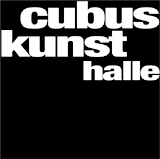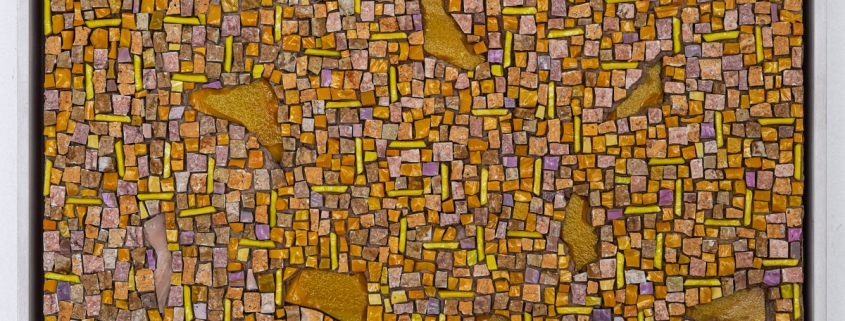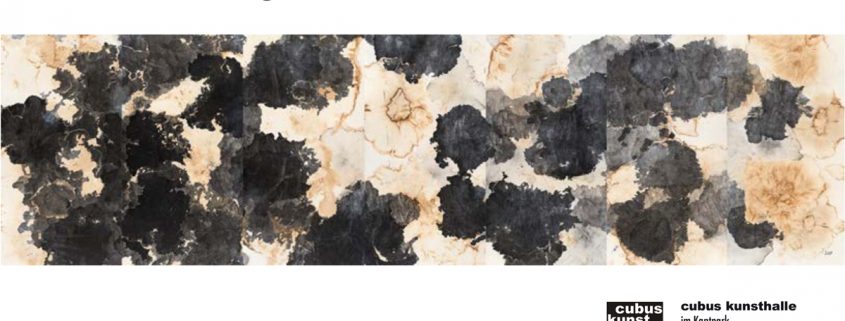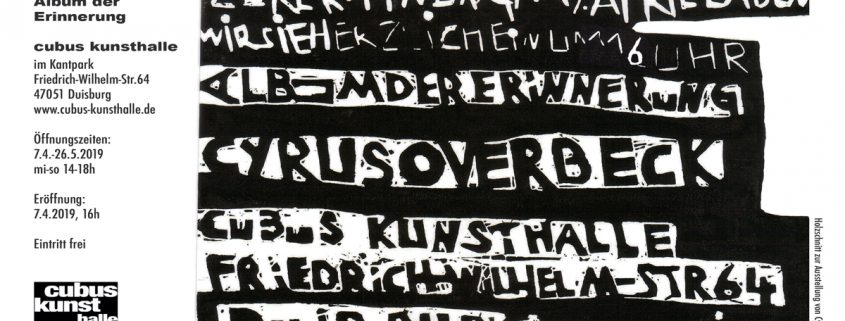YUAN LIAO. Die Elegie des Flusses 1.09.2019 – 3.10.2019 – Midissage 22.9.19 ,17h
/0 Kommentare/in Ausstellungen, Kunst, Künstler /von Miriam AndersÖffnungszeiten / opening hours:
mittwochs – sonntags / wednesday – Sunday
14 h – 18 h – Eintritt frei / Entree free
MIDISSAGE 22.09.2019 , 17 h
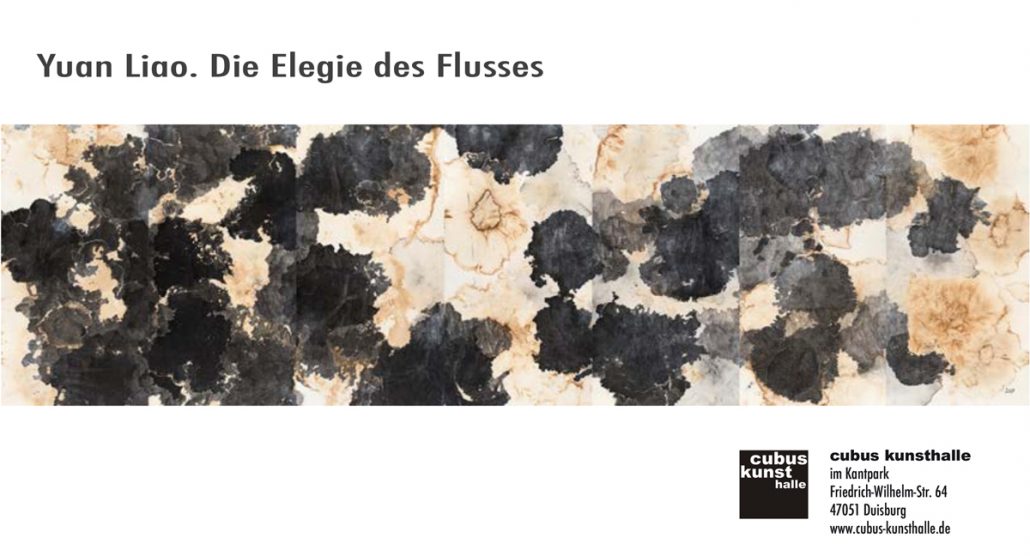
The Elegy of the River
About Liao Yuan’s Art
1
Liao Yuan was born in the southwest of China. In 1990’s, He came through thousands miles from Sichuan to Shanghai. After years of hard working. He has gained remarkable achievements. Now, he is not only the editor-in-chief of the most important art magazine in China, a profoundly educated art theorist, but also a pioneering artist in Chinese contemporary art scene. Although he has done so many different jobs, there is always an inextricable connection to art, and he has never stopped his artistic creation.
Liao yuan has studied Chinese calligraphy and painting since an early age. He received systematic art education in the college and has been using ink such traditional medium to create art for nearly 30 years. Such education background and experiences have made him well aware of the characteristics of water and ink in painting. With his long-term creative practice, he has formed his unique creative approach.
Liao Yuan is not a religious believer, but he firmly believes that everything has its spirit, and artistic creation dwells in the spiritual world. It has a complex and unknown trajectory. Time and space, the universe and life, fate and movement are the theme of his works. Unknown, consciousness, flowing transformed to become his painting elements in motion. All of these are the sources of Liao Yuan’s art.
2
In recent years, “The Elegy of the River” has become the main line of Liao Yuan’s artistic creation. Ancient China was centered in the Yellow River, and the Yellow River civilization had a great influence to the world. The social and cultural fields of Modern China has experienced from flourishing to declining, which is presented as the situation of “Western Learning spreading to the East”. The creation of “The Elegy of the River” series is Liao Yuan’s attachment and reflection on ancient Chinese civilization, and also the exploration and questioning of the relationship between the individual and the world.
The series paintings “River Map” is an important part of “The Elegy of the River.” In ancient China, the river map was a kind of mysterious knowledge that communicated with the heaven. It was “simplistic and profound.” The paintings in “River map” series are like the hexagram of “Embarrassment” of I Ching., which combines different factors such as time, space and cultural concepts with a mysterious movement of heaven and earth. All the factors finally merge into the rich river map and constitutes a form that has the meaning of travelling through time and space. Here, Liao Yuan seems to be fascinated by the exploration of the unknown. The dots in the paintings are regularly arranged and rotated like “particles”, which created a vast universe belonging to themselves. In the end, “River map” turns uncertain things into certainty, presents a sense of movement, and finds interesting and fresh things from the unknown, which is exactly what Liao yuan is searching for.
“The Appearances of skins” is another theme of Liao Yuan’s recent artwork. The lines are meticulous, neat and rich. Very detailed depiction and concise images form the unity of this series of paintings. The details with chaos and the accumulation of ink brushstrokes construct a solid fulcrum inside the picture. The simplistic composition contrasts with the complicated ink marks in the picture. Liao Yuan abstracts everything in a symbolic language. He removes the excessive impurities in the space and uses a symbolic painting language to release a highly concentrated and condensed image. “The Appearances of skins” series establishes his overall painting concept and style.
Liao Yuan’s “The Elegy of the River” are divided into two categories, one uses the form of “multiple”: ink accumulation and complexity, and another is in simplistic “less” pattern. The former is like a map or cartography; the latter is like the sky and the constellations. The former category is painted in dark ink and the latter category is painted in light tone. The images of the two same as Yin and Yang, which symbolize the beginning of the universe: Yin and Yang/ heaven and earth constitutes the mysterious world.
3
Liao Yuan’s painting manners are uncertain and fluid. They are the paintings about the ontology of painting. He is good at using ink, sometimes mix with tea and mineral pigments, to present many unexpected changes and uncertainties on rice paper.
First of all, he insisted on using materials such as rice paper, ink, tea, mineral pigment and other Chinese cultural attributes. He strives to dig out the physical and special cultural characteristics of traditional Chinese painting, so that the picture could maintain the cultural extension: the materials with oriental characteristics were reconstructed, spread and generated. Deeply nourished by traditional Chinese culture, he explores a grand spiritual theme that is constructed in detail. They are the appearance of micro and macro alteration. The re-definition of the extraordinary material intervention and generation, in the process of conflict and integration, has made a theological extension-the illusion of space and time, the complex psychological folds that are unpredictable for the future, this is the “infinite” in Chinese.
Secondly, in Liao yuan’s series paintings, we can see his profound understanding of the “quality” of the painting language. He has a habit of collecting Neolithic Chinese pottery, Wei and Jin Dynasties’ stone carvings, and a large number of ancient inscriptions and books. This becomes his inexhaustible spiritual nourishment. The styles and tastes of Chinese calligraphy make him seem to have the mysterious power at every point and line in his paintings. Meantime, in every painting’s unique time and space, each line is like a scratch of endless time, which symbolizes the moment and eternity: the creation of everything between heaven and earth which beyond time and space.
The view of “The Elegy of the River” just like “looking at the sky from the plateau, it is so quiet.” In the land of Chinese civilization with the river as its core, and on the rich soil of the Yellow River Basin, Liao yuan’s art revolves around the themes of universe, time, life, destiny, and movement, which allows the audiences to enter a state of enlightenment and meditation, to stand in the double emptiness of time and space, to feel the ubiquitous meditation between heaven and earth.
4
After the encounter with modern civilization, where should Chinese traditional culture go? This issue has been questioned by many Chinese intellectuals. After experiencing the impact of various modern cultural thoughts and movements, some intellectuals and artists have begun to re-recognize and re-interpret Chinese tradition, and attempts to break through. Liao Yuan is one of the active thinkers and explorers. His paintings with the theme of “The Elegy of the River” are the looking back and tribute to Chinese traditional culture. It is a reflection on the encounter of Chinese traditional culture in contemporary society, and also, it is a reshaping and activation of the tradition. In this sense, I think that Liao Yuan’s “The Elegy of the River” can be regarded as the witness of the “Nirvana” of the “Yellow River Civilization”.
Like traditional Chines literati, Liao Yuan pays great attention to self-cultivation and emphasizes the significance of individuality in cultural practice, but he is not a cultural nationalist. He is a contemporary person who pursues universal values. In his exploration of the uniqueness of Chinese modern art, he plays the role of an “inheritor”, and actively incorporates global art with an open mind. His transformation of Chinese traditional culture is a positive response to globalization. Liao Yuan’s “The Elegy of the River” draws nutrients and wisdom from Chinese tradition to achieve a transcendental state of “No question whether the East or the West”. His constant reaffirmation and transformation of Chinese traditional culture is not only a response to the question of where ancient Chinese civilization should go after encountering modern time, but also an active participation in global multiculturalism. Adhering to the Chinese traditional concept of “Writings are for Conveying Truth”, he firmly believes that no matter what kind of art, artwork should express some kind of spiritual truth not just a superficial form. He hopes that the seeds of Chinese traditional culture will bear fruits of contemporary significance in today’s globalization.
In short, as a very important explorer in the field of Chinese contemporary art scene, Liao Yuan is reconstructing the aesthetic mechanism of Chinese painting with his rich artistic creation and opening up a path for us to recognize and understand Chinese traditional culture.
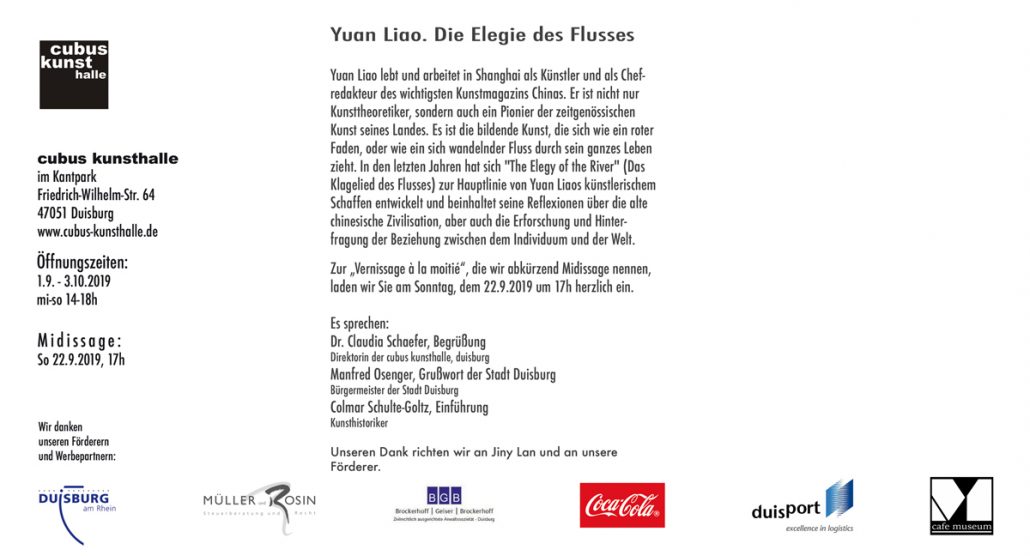
CYRUS OVERBECK „Album der Erinnerung“ Eintritt frei
/0 Kommentare/in Ausstellungen, Kunst, Künstler /von Miriam Anders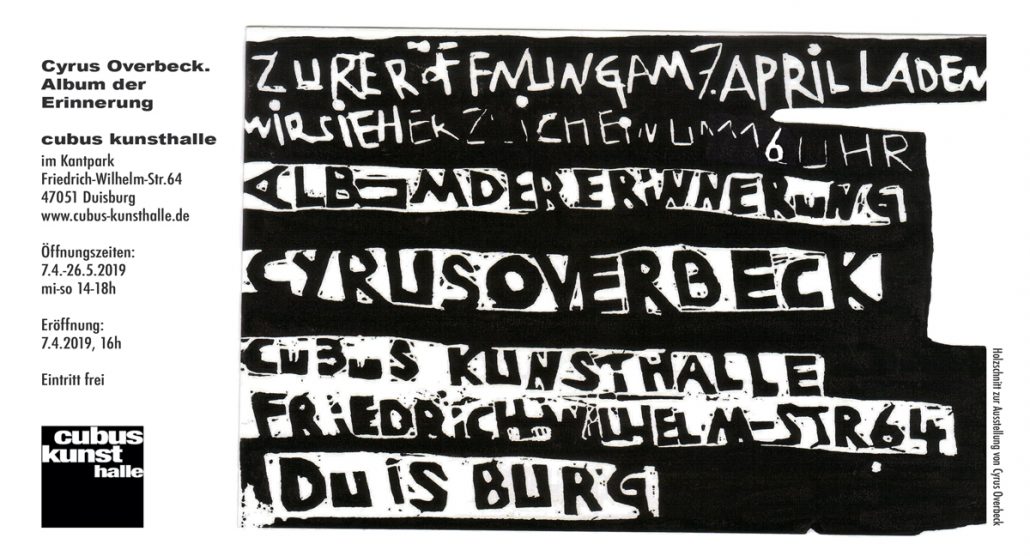
Herzlich
laden wir Sie zur Eröfnung der Ausstellung Cyrus Overbeck .
– Album der Erinnerung – Kunst zwischen kollektiv medialem und individuellem Erinnern,
7.4.2019 um 16h in die cubus kunsthalle, duisburg ein.
Die Ausstellung wird am 7.4.2019 um 16h von Sören Link, Oberbürgermeister der Stadt Duisburg eröffnet.
Wir danken der Sparkasse Duisburg-Stiftung für ihre freundliche Unterstützung.
Bitte beachten Sie auch die im Obergeschoß laufende Ausstellung
EUROPA.Wir haben die Wahl
verlängert im Obergeschoss bis zum 26.5.2019
Im Vorfeld der diesjährigen Europawahl zeigt die cubus kunsthalle kurzfristig eine Ausstellung, in der Besucher Einblicke erhalten, die den Blick auf unser Europa schärfen. Künstler wurden aufgefordert, ihre Statements abzugeben und um diese herum formieren sich Workshop Angebote, die aus der Ausstellung ein lebendiges interaktives Erlebnis machen. Die Ausstellung greift auch unsere Fragen, Fragen der Europabürger, auf: Was gilt es zu verbessern? Gibt es Wege aus der Krise? Kommt der Brexit oder kommt die Queen mit einem blauen Auge davon? Was ist los in unseren Nachbarländern? Der Aufstand der Gelbwesten und Macron, Sebastian Kurz und die Einwanderpolitik? Wie sind rechtsextreme Strömungen in den EU Ländern zu stoppen? So gibt es Stimmen, die davor warnen, dass sich Europas Rechtspopulisten verbündet haben und einen Umsturz in der EU-Asylpolitik planen. Noch können wir uns wehren.
Bei allen Unzulänglichkeiten wäre es aber fatal, jetzt, im Mai 2019, Europa durch unser Nichtwählen zu strafen. Dies würde den rechtextremen Strömungen nur weiter den Weg bereiten. Wir müssen durch unser Votum dagegenhalten. Jetzt zeigt sich, wie stark unsere Demokratie ist. Europa steht am Scheideweg und jede Stimme zählt!
Somit wird diese anstehende Wahl zu einer Schicksalswahl.
Die Ausstellung in der cubus kunsthalle, duisburg ist geöffnet ab dem 10.4.2019
mi-so 14-18h .
Eintritt frei.
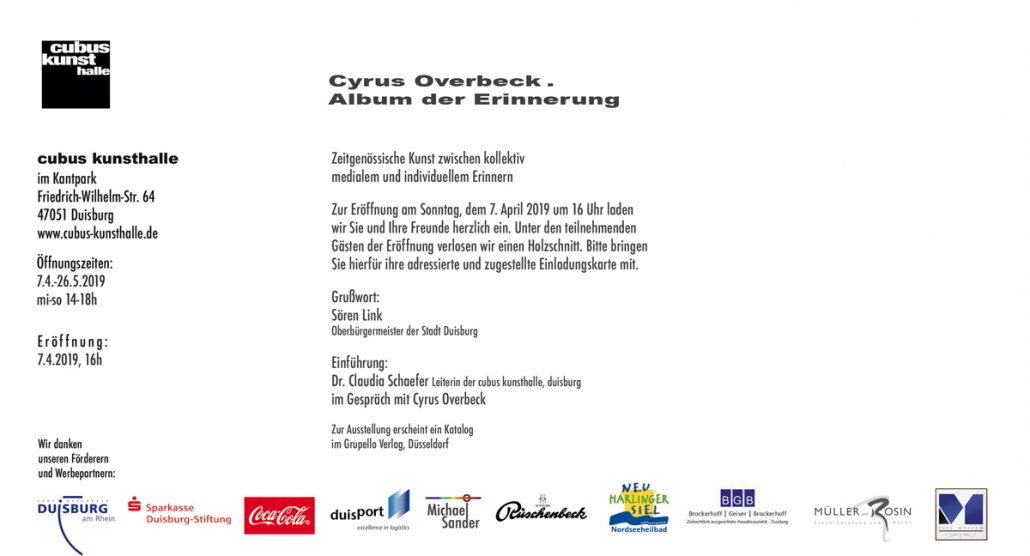
Cyrus Overbeck . Album der Erinnerung
Kunst zwischen kollektiv medialem und individuellem Erinnern,
Kunst zwischen Empathie und Abstraktion
7.4. – 26.5.2019
„Ich bin Künstler, ich erzähle, was ich sehe und erlebe. In Holz, in Bronze, auf Öl, auf Leinwand, Metall und auf Stein.“
Geboren 1970 verlebt Cyrus Overbeck seine Kindheit als Sohn eines persischen Vaters und seiner deutschen Mutter bis 1979 in Teheran.
1986 beginnt er seine künstlerische Auseinandersetzung in seinem ersten Atelier – in der stillgelegten Brotfabrik des Großvaters in der Arnold-Overbeck-Straße 58 – in Duisburg, die mittlerweile unter Denkmalschutz steht. 1988 schafft er sich die erste eigene Radierpresse an. Im Jahre 1989 erlangt er in Duisburg sein Abitur. Ab 1990 arbeitet er auf Haus Esselt im Pankok-Museum in Hünxe-Drevenack am Niederrhein. Von 1990 bis 1995 schließt sich ein Lehramtsstudium Sekundarstufe I und II an. Seit 1995 arbeitet Cyrus Overbeck freischaffend in seinem Atelier in Duisburg-Beek und konzentriert sich auf großformatige Radierungen und Holzschnitte.
Von 1997 bis 1999 hat er einen Lehrauftrag für Druckgrafik an der Universität Duisburg inne. Im Anschluss folgen bis 2001 Aufenthalte in Carlsbad, Kalifornien.
Das denkmalgeschützte „Becker-Haus“ im norddeutschen Esens, erwirbt Overbeck 2003 und nutzt es als Atelier. Im Jahre 2000 eröffnet er weitere Ateliers in Neulouisendorf bei Kalkar und in Dornum (Norddeutschland), in welchen eine Vielzahl großformatiger Landschaftsradierungen und Holzschnitte entstehen. 2003 erwirbt er das Bürgermeister-Becker-Haus in Esens und baut dies ebenfalls zu einem Atelier um. Von 2004 bis 2007 arbeitet er dort als Lehrer für die Fächer Deutsch, Ev. Theologie, Kunst und Geschichte
Im Jahre 2007 folgt ein Aufenthalt in New York, bei dem kleinformatige Ölgemälde und Aquarelle entstehen. Seit 2010 kooperiert Cyrus Overbeck mit der Johannes-Gutenberg-Universität Mainz, dem Forschungsschwerpunkt Medienkonvergenz, und unterhält ein offenes Atelier in der Mainzer Innenstadt. Es folgt eine akademische Auseinandersetzung mit dem Thema Künstler und Kulturindustrie. Hierdurch erfolgen multiple Medienpräsenzen in Radio, Fernsehen und den Print-Medien. 2013 wird das Atelier in Düsseldorf-Flingern (Hermannstraße 38) eröffnet. Im Jahre 2013 beginnt er mit dem Bau einer neuen Radierpresse, auf der Formate bis 240 cm Länge gedruckt werden können. 2018 wird Overbeck in die Jury des Gutenberg-Museums Mainz berufen.
Als narrativer Realist ist Overbeck erzählend für viele Werte eintreten. Er drückt es einmal so aus (Zitat) „Über allen Werten steht für mich etwas, an dem es in unserer Gesellschaft immer mehr mangelt: die Glaubwürdigkeit. Es geht mir bei der Glaubwürdigkeit um die Übereinstimmung von Wort und Werk, von Haltung und Handlung.“ Aus dieser, seiner Haltung spricht Authentizität, die sich in seinen Werken widerspiegelt. In der bildenden Gegenwartskunst kann er wohl auch zu den letzten Geschichtenerzählern zwischen „Abstraktion und Einfühlung“ gezählt werden. Seine Holzschnitte, seine Bronzen, seine Arbeiten in Öl und seine Radierungen sprechen mit dem Betrachter. Sie erzählen von seiner Sehnsucht nach Liebe, Frieden und Geborgenheit. Sie berichten über persönliche Erfahrungen mit Verzweiflung, mit dem Tod und mit verzweifelten Menschen. Sie erzählen von seinen Versuchen, das Grauen von Flucht, totalitären Staaten, Unterdrückung und Völkermord anzusprechen. Sie drücken seine Sorge angesichts der Entdemokratisierung europäischer Gesellschaften aus. Overbecks Kunst erzählt auch von Religion. In seinen Arbeiten sind die großartigen Verflechtungen der Weltreligionen eingewoben, in denen Overbeck selbst Kind, Jugendlicher, Pädagoge und Künstler geworden ist: Katholizismus, Protestantismus, das Judentum und das muslimische Weltverständnis spielen dabei oft eine simultane Rolle. Für dieses offene Weltverständnis ist Cyrus Overbeck nicht zuletzt anlässlich der Aufnahme in die European Academy of Sciences and Arts, in Salzburg, gewürdigt worden.
Album der Erinnerung. So ist die Ausstellung in der cubus kunsthalle, duisburg von ihm betitelt worden. Die Erinnerung ist immer auch eine Art Rückkehr. Rückkehr nach Duisburg in das Atelier in der alten Brotfabrik in Beek, Rückkehr auch in die cubus kunsthalle, in der Cyrus Overbeck bereits vor 20 Jahren eine seiner vielen Wirkungsstätten hatte. Und Rückkehr zu seinem damals, in der Zeit seiner künstlerischen Anfänge, präferiertem Ausdrucksmittel: dem Holzschnitt.
Die Ausstellung wird am 7.4.2019 um 16h von Sören Link, Oberbürgermeister der Stadt Duisburg eröffnet.
Wir danken der Sparkasse Duisburg-Stiftung für ihre freundliche Unterstützung.
cubus kunsthalle, duisburg geöffnet mi-so 14-18h, Eintritt frei www.cubus kunsthalle.de
Interessante Links
Hier findest Du ein paar interessante Links! Viel Spaß auf unserer Website :)Seiten
- About us (EN / CH)
- Ausstellungen
- Blog
- Das Schüleratelier und Workshops
- Datenantrag
- Datenlöschantrag
- Datenschutzerklärung
- Der Förderverein
- Die Sponsoren
- Dr. Claudia Schaefer
- DSGVO
- Duisburger Mercatorkugel
- Eventlocation
- Impressum
- Kommanditisten
- Kontakt I Bewerbungsverfahren I Jobs
- Sponsoring – Pakete und Preise
- Startseite
- Terminkalender
- Werbemöglichkeiten und Preise
- Wir über uns
Kategorien
- Aktuell
- Aktuelle Ausstellung
- Aktuelle Kinderworkshops
- Allgemein
- Angebote
- Ausstellungen
- Cubus
- Cubus Club
- Cubus Event: Familien- und Firmenfeiern
- Cubus Shop
- Eventlocation
- Externe aktuelle Angebote
- Kids-Workshop
- Kinder
- Kunst
- Künstler
- Kunstmarkt
- Mitmachausstellungen
- Nächste Ausstellung
- Neue Ausstellungen
- Presseecho
- Projekte
- Sonstiges
- Start
- Terminkalender
- Veranstaltungen
- Workshops
